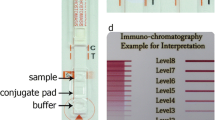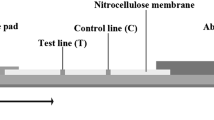Abstract
Gnathostoma spinigerum infection is endemic in Thailand and many Asian countries. Current diagnosis is the skin test and enzyme-linked immunosorbent assay (ELISA) for IgG antibody against the G. spinigerum third-stage larvae (L3), but cross-reactivity is common. We evaluated the sensitivity and specificity of anti-G. spinigerum L3 IgG subclass antibodies for diagnosis of 43 patients with gnathostomiasis. The majority of patients with gnathostomiasis (91%) had eosinophilia. While the anti-G. spinigerum L3 IgG1 antibody provided the highest sensitivity (98%), the anti-G. spinigerum L3 IgG2 antibody had the highest specificity (88%). The ELISA that detected anti-G. spinigerum L3 IgG1 antibody could be a reliable laboratory screening test, while anti-G. spinigerum L3 IgG2 antibody could be used to confirm the diagnosis.

Similar content being viewed by others
References
Aalberse RC, van der Gaag R, van Leeuwen J (1983) Serologic aspects of IgG4 antibodies. I. Prolonged immunization results in an IgG4-restricted response. J Immunol 130:722–726
Anantaphruti M (1989) ELISA for diagnosis of gnathostomiasis using antigens from Gnathostoma doloresi and G. spinigerum. Southeast Asian J Trop Med Public Health 20:297–304
Boongird P, Phuapradit P, Siridej N, Chirachariyavej T, Chuahirun S, Vejjajiva A (1977) Neurological manifestations of gnathostomiasis. J Neurol Sci 31:279–291
Boot JH, Geerts ME, Aarden LA (1989) Functional polymorphisms of Fc receptors in human monocyte-mediated cytotoxicity towards erythrocytes induced by murine isotype switch variants. J Immunol 142:1217–1223
Chanthachume N, Kulkhumthorn M, Jongwutiwes S (1988) Evaluation of skin test for human gnathostomiasis. Chula Med J 32:243–248
Chatterjee BP, Santra A, Karmakar PR, Mazumder DN (1996) Evaluation of IgG4 response in ascariasis by ELISA for serodiagnosis. Trop Med Int Health 1:633–639
Chhuon H, Sangkim K, Voeunthal Y (1976) Mobile edema of the face and neck followed by intraocular localization of Gnathostoma spinigerum. Bull Soc Pathol Exot Filiales 69:347–351
Chitanondh H, Rosen L (1967) Fatal eosinophilic encephalomyelitis caused by the nematode Gnathostoma spinigerum. Am J Trop Med Hyg 16:638–645
Daengsvang S (1980) A monograph on the genus Gnathostoma and gnathostomiasis in Thailand. Southeast Asian Medical Information Center, Tokyo
Daengsvang S (1981) Gnathostomiasis in Southeast Asia. Southeast Asian J Trop Med Public Health 12:319–332
Daengsvang S (1986) Gnathostoma spinigerum and human gnathostomiasis. In: Sucharit S, Areekul S, Sucharit P, Vanijanonta S, Kitikoon V, Chanpachum Y (eds) The 25th anniversary of the Faculty of Tropical Medicine, Mahidol University. Krung Siam, Bangkok, pp 124–147
Davidson RA (1985) Immunology of parasitic infections. Med Clin North Am 69:751–758.
Dekumyoy P, Komalamisra C, Nuamtanong S, Nacapunchai D, Sinnawong M, Shanaha P, Piyasatittam P (2000) Angiostrongyliasis: analysis of antigens of Angiostrongylus costaricensis adult worms versus IgG from infected patients with Angiostrongylus cantonensis. Southeast Asian J Trop Med Public Health 31 [Suppl 1]:48–53
Dharmkrong-at A, Migasena S, Suntharasamai P, Bunnag D, Priwan R, Sirisinha S (1986) Enzyme-linked immunosorbent assay for detection of antibody to Gnathostoma antigen in patients with intermittent cutaneous migratory swelling. J Clin Microbiol 23:847–851
Geiger SM, Laitano AC, Sievers-Tostes C, Agostini AA, Schulz-Key H, Graeff-Teixeira C (2001) Detection of the acute phase of abdominal angiostrongyliasis with a parasite-specific IgG enzyme linked immunosorbent assay. Mem Inst Oswaldo Cruz 96:515–518
Grimm F, Maly FE, Lu J, Llano R (1998) Analysis of specific immunoglobulin G subclass antibodies for serological diagnosis of echinococcosis by a standard enzyme-linked immunosorbent assay. Clin Diagn Lab Immunol 5:613–616
Grieve RB (1990) Immunologic relevance of the cuticle and epicuticle of larval Dirofilaria immitis and Toxocara canis. Acta Trop 47:399–402
Jaroonvesama N, Charoenlap K, Buranasin P, Zaraspe GG, Cross JH (1985) ELISA testing in cases of clinical angiostrongyliasis in Thailand. Southeast Asian J Trop Med Public Health 16:110–112
Khairul A, Farhat A, Dwijadas B, Netai P, Subhasis KG, Rama PG, Pratap NG, Shiben KS, Nahid A (1999) Immunoglobulin subclass distribution and diagnostic value of Leishmania donovani antigen-specific immunoglobulin G3 in Indian Kala-Azar patients. Clin Diagn Lab Immunol 6:231–235
Kraivichian P, Kulkumthorn M, Yingyourd P, Akarabovorn P, Paireepai CC (1992) Albendazole for the treatment of human gnathostomiasis. Trans R Soc Trop Med Hyg 86:418–421
Lewis E, Hunter SJ, Tetley L, Nunes CP, Bazzicalupo P, Devaney E (1999) Cut-1-like genes are present in the filarial nematodes, Brugia pahangi and Brugia malayi, and, as in other nematodes, code for components of the cuticle. Mol Biochem Parasitol 101:173–183
Lowry OH, Rosenbrough NJ, Farr AL, Randall RJ (1951) Protein measurement by the Folin phenol reagent. J Biol Chem 193:265–275
Maleewong W, Morakote N, Thamasonthi W, Charuchinda K, Tesana S, Khamboonruang C (1988) Serodiagnosis of human gnathostomiasis. Southeast Asian J Trop Med Public Health 19:201–205
Migasena S, Pitisuttithum P, Desakorn V (1991) Gnathostoma larva migrans among guests of a New Year party. Southeast Asian J Trop Med Public Health 22:225–227
Miyazaki I (1960) On the genus Gnathostoma and human gnathostomiasis, with special reference to Japan. Exp Parasitol 9:338–370
Moorhouse DE, Bhaibulaya M, Jones HI (1970) Suspected human gnathostomiasis in Queensland. Med J Aust 1:250
Nopparatana C, Setasuban P, Chaicumpa W, Tapchaisri P (1991) Purification of Gnathostoma spinigerum specific antigen and immunodiagnosis of human gnathostomiasis. Int J Parasitol 21:677–687
Nuchprayoon S, Yentakam S, Sangprakarn S, Junpee A (2001) Endemic bancroftian filariasis in Thailand: detection by Og4C3 antigen capture ELISA and the polymerase chain reaction. J Med Assoc Thai 84:1300–1307
Nuchprayoon S, Siriyasatien P, Kraivichian K, Porksakorn C, Nuchprayoon I (2002) Prevalence of parasitic infections among Thai patients at the King Chulalongkorn Memorial Hospital, Bangkok, Thailand. J Med Assoc Thai 85 [Suppl 1]:S415–423
Ogata K, Nawa Y, Akahane H, Diaz Camacho SP, Lamothe-Argumedo R, Cruz-Reyes A (1998) Short report, gnathostomiasis in Mexico. Am J Trop Med Hyg 58:316–318
Ollague W, Ollague J, Guevara de Veliz A, Penaherrea S (1984) Human gnathostomiasis in Ecuador (nodular migratory eosinophilic panniculitis). First finding of the parasite in South America. Int J Dermatol 23:647–651
Pirompakdi Y (1984) Clinical manifestations of Gnathostoma spinigerum infection. Report of 236 cases. Rama Med J 7:207–215
Punyagupta S, Juttijudata P (1968) Two fatal cases of eosinophilic myeloencephalitis a newly recognized disease caused by Gnathostoma spinigerum. Trans R Soc Trop Med Hyg 62:801–809
Rahmah N, Anuar AK, Karim R, Mehdi R, Sinniah B, Omar AW (1994) Potential use of IgG2-ELISA in the diagnosis of chronic elephantiasis and IgG4-ELISA in the follow-up of microfilaraemic patients infected with Brugia malayi. Biochem Biophys Res Commun 205:202–207
Rojas-Molina N, Sanchez SP, Bibiano BT, Martinez HM, Gutierrez AE (1999) Gnathostomiasis, and emerging foodborne zoonotic disease in Acapulco, Mexico. Emerg Infect Dis 5:264–266
Rojekittikhun W, Pubampen S, Hiranyachattada P, Chiamratana B, Setasuban P (1989) A survey on the infective larvae of Gnathostoma spinigerum in fresh water fish sold in the local markets of Bangkok. J Trop Med Parasitol 2:7–12
Rusnak JM, Lucey DR (1993) Clinical gnathostomiasis: case report and review of the English-language literature. Clin Infect Dis 16:33–50
Sakolvaree Y, Ybanez L, Chaicumpa W (1997) Parasites elicited cross-reacting antibodies to Opisthorchis viverrini. Asian Pac J Allergy Immunol 15:115–122
Saksirisampant W, Chawengkiattikul R, Kraivichian K, Nuchprayoon S (2001) Specific IgE antibody responses to somatic and excretory-secretory antigens of third stage G. spinigerum larvae in human gnathostomiasis. J Med Assoc Thai 84 [Suppl 1]:173–181
Saksirisampant W, Kulkaew K, Nuchprayoon S, Yentakham S, Wiwanitkit V (2002) A survey of the infection larvae of Gnathostoma spinigerum in swamp eels bought in a local market in Bangkok, Thailand. Ann Trop Med Parasitol 96:191–195
Schmutzhard E, Boongird P, Vejjajiva A (1988) Eosinophilic meningitis and radiculomyelitis in Thailand, caused by CNS invasion of Gnathostoma spinigerum and Angiostrongylus cantonensis. J Neurol Neurosurg Psychiatry 51:80–87
Soesatyo MH, Rattanasiriwilai W, Suntharasamai P, Sirisinha S (1987) IgE responses in human gnathostomiasis. Trans R Soc Trop Med Hyg 81:799–801
Stites DP, Stobo JD, Fudenberg HH, Wells JV (1982) Basic and clinical immunology, 4th edn. Lauge Medical, Maruzen, Asia
Suntharasamai P, Desakorn V, Migasena S, Bunnag D, Harinasuta T (1985) ELISA for immunodiagnosis of human gnathostomiasis. Southeast Asian J Trop Med Public Health 16:274–279
Taamasri P, Leelayoova S, Rangsin R, Naaglor T, Ketupanya A, Mungthin M (2002) Prevalence of Blastocystis hominis carriage in Thai army personnel based in Chonburi, Thailand. Mil Med 167:643–646
Tapchaisri P, Nopparatana C, Chaicumpa W, Setasuban P (1991) Specific antigen of Gnathostoma spinigerum for immunodiagnosis of human gnathostomiasis. Int J Parasitol 21:315–319
Triteeraprapab S, Nuchprayoon I (1998) Eosinophilia, anemia, and parasitism in a rural region of Northwest Thailand. Southeast Asian J Trop Med Public Health 29:584–590
Triteeraprapab S, Thumpanyawat B, Sangprakarn S (1998) Wuchereria bancrofti-specific circulating antigen for diagnosis of bancroftian filariasis. Chula Med J 42:267–277
Triteeraprapab S, Karnjanopas K, Suwannadabba S, Sangprakarn S, Poovorawan Y, Scott AL (2000) Transmission of the nocturnal periodic strain of Wuchereria bancrofti by Culex quinquefasciatus: establishing the potential for urban filariasis in Thailand. Epidemiol Infect 125:207–212
Triteeraprapab S, Karnjanopas K, Porksakorn C, Sai-Ngam A, Yentakam S, Loymak S (2001a) Lymphatic filariasis caused by Brugia malayi in an endemic area of Narathiwat Province, Southern of Thailand. J Med Assoc Thai 84 [Suppl 1]:S182–188
Triteeraprapab S, Nuchprayoon I, Porksakorn C, Poovorawan Y, Scott AL (2001b) High prevalence of Wuchereria bancrofti infection among Myanmar migrants in Thailand. Ann Trop Med Parasitol 95:535–538
Tuntipopipat S, Chawengkiattikul R, Witoonpanich R, Chiemchanya S, Sirisinha S (1989) Antigens, antibodies and immune complexes in cerebrospinal fluid of patients with cerebral gnathostomiasis. Southeast Asian J Trop Med Public Health 20:439–446
Vejjajiva A (1978) Parasitic diseases of the nervous system in Thailand. Clin Exp Neurol 15:92–97
Waikagul J, Krudsood S, Radomyos P, Radomyos B, Chalemrut K, Jonsuksuntigul P, Kojima S, Looareesuwan S, Thaineau W (2002) A cross-sectional study of intestinal parasitic infections among schoolchildren in Nan Province, Northern Thailand. Southeast Asian J Trop Med Public Health 33:218–223
Wilairatana P, Radomyos P, Radomyos B, Phraevanich R, Plooksawasdi W, Chanthavanich P, Viravan C, Looareesuwan S (1996) Intestinal sarcocystosis in Thai laborers. Southeast Asian J Trop Med Public Health 27:43–46
Zakroff SG, Beck L, Platzer EG, Spiegelberg HL (1989) The IgE and IgG subclass responses of mice to four helminth parasites. Cell Immunol 119:193–201
Acknowledgements
This study was supported by Ratchadapisek-sompotch Fund, Faculty of Medicine, Chulalongkorn University, Bangkok, Thailand. We would like to thank Ms. Narak Triteeraprapab for data analysis. We are thankful to all staff at the Hematology unit, the Department of Pediatrics, and the Department of Parasitology, Faculty of Medicine, Chulalongkorn University, for their technical help.
Author information
Authors and Affiliations
Corresponding author
Rights and permissions
About this article
Cite this article
Nuchprayoon, S., Sanprasert, V., Suntravat, M. et al. Study of specific IgG subclass antibodies for diagnosis of Gnathostoma spinigerum . Parasitol Res 91, 137–143 (2003). https://doi.org/10.1007/s00436-003-0947-x
Received:
Accepted:
Published:
Issue Date:
DOI: https://doi.org/10.1007/s00436-003-0947-x




